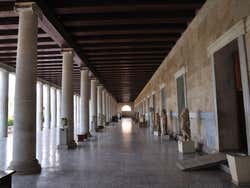
Ancient Agora of Athens
The Ancient Agora of Athens was the social, political and commercial hub of the city during Ancient Greece. This "meeting place" is the best kept example of an Agora.
Agoras in Ancient Greece were public squares where the inhabitants would meet to discuss politics and their quotidian lives. It is also where elections, religious celebrations, athletic competitions and various types of shows were held. Furthermore, they were also important commercial spaces and considered the heart of the city.
Functions
Agoras were always large open spaces surrounded by various public buildings and had very diverse functions:
- Governmental functions: The Agora was where the citizens would meet up to debate about the various laws and future of the city.
- Spiritual area: The temples to the various Greek gods surrounded the Agora.
- Markets: An open-air market would take place in the Agoras.
Agora excavation
The first excavations in the Agora area took place between 1859 and 1912. During the following years, important remains, including large sculptures, were found in a deep trench when the railway tracks were being installed.
Subsequently, 360 modern edifices were demolished to expose the whole Agora. When the entire area was excavated, the Stoa of Attalos, a large building constructed during the Hellenistic period, was rebuilt according to the original plans. Nowadays, it features the Ancient Agora Museum.
Ancient Agora Museum
The Ancient Agora Museum was founded in 1957 and housed in the Stoa of Attalos, a two-story rectangular building with a long sequence of columns. It was given to Athens by the King Attalus of Pergamon.
The museum’s collection contains various items found during the excavations of the Ancient Agora, like ceramics, jewels, weaponry and coins.
The Ancient Agora presently
Although most of the buildings in the Agora are not very well preserved, some of the most prominent edifices have been reconstructed extremely well like the Stoa of Attalos, an ancient department store, currently housing the Ancient Agora Museum. The Agora is also home to the Temple of Hephaestus, one of the best-preserved temples of Ancient Greece. It was built between 449 and 415 BCE.
The Ancient Agora is one of the capital’s most special landmarks. Although most of the area’s constructions are badly damaged, the historic importance of this archaeological site make it a must-see visit for all visitors.



Schedule
Every day from 8:00 a.m. to 5:00 p.m.
Closed: January 1, March 25, May 1, Easter Sunday, December 25 and 26.
Price
Adults: 10 EUR
Students: 5 EUR
Combined adults: 30 EUR
The combined admission includes: Acropolis, Ancient Agora, Roman Agora, Theater of Dionysus, Kerameikos, Temple of Olympian Zeus, Hadrian's Library, and the Aristotelian Lyceum.
Transport
Metro: Monastiraki, lines 1 and 3; Thiseio, line 1.
Nearby places
Monastiraki (301 m) Hadrian's Library (334 m) Roman Agora (363 m) Kanellopoulos Museum (401 m) Museum of Greek Folk Musical Instruments (430 m)

